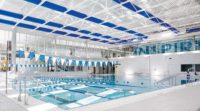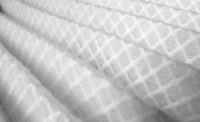Air cleaning has become a necessity over the past couple of years because of the pandemic. Whether it be in offices, schools, health care facilities or residential buildings, air cleaning has become a primary focus. People want to be assured they are in facilities where the air is not harmful to breathe.
For years, professionals have looked at IAQ and indoor environmental quality (IEQ) criteria when designing new and retrofit facilities. A primary goal of an IAQ/IEQ and air-cleaning program is to minimize occupant exposure to pollutants from air contaminants that generally fall into one of these categories: biological contaminants, chemical pollutants, particulates, and organic and inorganic dust.
As buildings have become tighter with improved building envelope systems and inoperable windows to minimize energy use, IAQ and IEQ have become primary considerations for professional engineers and architects. This newfound attention is focused on minimal ventilation rates that are dictated by codes and standards with the objective of minimizing the cost of cooling, heating, filtering, humidifying, and dehumidifying the outside air.
Many questions arise when the topic of air cleaning is brought up. What is clean air and how do professional engineers and public health officials ensure facilities have clean air? Should there be inspectors that go into buildings to ensure the air is clean? Are maintenance staff members trained to maintain all products that are part of an air distribution and air cleaning systems within a building? These (and others) are all good, logical questions, but the answers may not be as obvious as the general public might perceive or desire. The experts in engineering and science don’t even all agree with what may be good enough when it comes to air cleaning.
What should a professional engineer do regarding air cleaning when designing a new or retrofit facility? Is first cost or maintenance cost the most important criteria? Should cost even be considered as a deciding factor when it comes to clean air that occupants of a building inhale? Is the “keep it simple” (KIS) strategy the most important or is the “keep it defendable” (KID) approach the wiser path to take on deciding what air-cleaning system to specify, commission, and maintain?
Defining Air Cleaning
A good place to start is to look at the definition of air cleaning. One definition of air cleaning, according to ASHRAE Terminology, is “the use of equipment that reduces the concentration of airborne contaminants, such as microorganisms, dusts, fumes, respirable particles, other particulate matter, gases, odors, and/or vapors in air.”
Everyone on the design team, including the owner, architect, engineer, consultants, etc., needs to agree with what definition of air cleaning is going to be used, since this will impact whether or not the design intent has been accomplished when the facility is commissioned, put into operation, and maintained by the facility owner. This basic agreement has a fundamental liability impact on all involved.
Air-distribution systems utilized in inhabitable spaces are also part of the air-cleaning system, since the effectiveness of the air distribution in the space impacts the recirculation of air contaminants in the space. There are multiple air system types that basically start with a decision of using a constant volume (CV) or variable air volume (VAV) system approach. Adhering to basic codes and industry standards impacts air diffuser selections, depending on whether a CV or VAV system is used. There are challenges with either type when it comes to consideration of energy use and comfort in the space for the occupants.
When designing new buildings or retrofitting existing buildings, one challenge for every professional engineer is meeting ASHRAE Standards 52, 62, and 90.1, which deal with comfort, ventilation, and energy, respectively. As a result of the pandemic, a national focus on ventilation has raised awareness of the importance of HVAC systems providing proper clean air to the spaces that are occupied by students, office workers, and health care professionals. Existing buildings may or may not be able to provide enhanced outside air quantities or air cleaning, depending on the equipment installed. Public pressure on environmentally safe indoor spaces has caused facility owners to reevaluate their systems and the budgets needed to enhance the HVAC systems to meet new expectations that may exceed current codes and standards.
One approach used, for a variety of reasons, is the use of sensors to monitor air quality directly. This follows the logic that what is not directly measured cannot be directly controlled. As with any design decision, the cost impact of purchasing, installing, and maintaining sensors should be clearly understood. Faced with the potential liability and concern for the health of the occupants, many facility owners are becoming more adamant that they want better HVAC system controls and monitoring as opposed to a lower first cost that can bring on more risk.
There is no doubt facility owners rely on design professionals to understand current codes, standards, and ongoing issues related to air cleaning. There is also no doubt the “buyer beware” cliché includes the fact that facility owners must step up to be involved in the building design decisions and ensure that all HVAC system installations can be validated (commissioned) and maintained to ensure that what is installed meets the design team’s performance design intent. The product manufacturers who promote products in response to changing needs and priorities in the building industry must ethically and honestly disclose the specifiable performance of products and be held accountable also.
When it comes to cost analysis of HVAC air cleaning related to occupant performance, there are studies that show that an appropriately ventilated and comfortable work space will allow occupants to be more productive. This increased productivity has been shown to far offset the first cost associated with the installation of HVAC products and controls that provide these features when they’re properly maintained and used by the facility owner.
Air contaminants can be generated by a facility owner from maintenance activities, pest control applications, housekeeping chemicals, renovation of spaces, new furnishings, or finishes that are made of certain chemicals and materials. Building occupant activities can also generate air contaminants by using copy machines and other technologies that increase employee efficiency without regard to discharge of contaminants.
According to the ASHRAE terminology, an air contaminant is “an unwanted airborne constituent that may reduce acceptability of the air.”
- A microorganism is defined as “a microscopic organism, especially a bacterium, fungus, or protozoan;”
- A particulate (particle) contaminant is discussed in the ASHRAE terminology resource in three definitions;
- Total suspended particulates is defined as “mass of particulates suspended in a unit volume of air as collected by an air sampler;”
- Airborne particles are defined as “impurities as solid or liquid particulate matter from whatever source;”
- Respirable particles are defined as “particles small enough to be inhaled into a nonciliated portion of the lung. Peak deposition of respirable particles occurs within the size range of 0.2-5 micrometers. Particles greater than 10 micrometers in aerodynamic diameter are not respirable;” and
- A gaseous contaminant is defined by ASHRAE Terminology as “one of the three basic states of matter, characterized by the greatest freedom of molecules and the lack of any inherent fixed shape or volume.”
There are a number of products that deal with air cleaning depending on contaminants of concern. As can be seen, the above list of contaminants does not include the word “virus” specifically, which, according to Merriam-Webster, is defined as “any of a large group of submicroscopic infectious agents that are usually regarded as nonliving, extremely complex molecules that typically contain a protein coat surrounding an RNA or DNA core of genetic material but no semipermeable membrane, that are capable of growth and multiplication only in living cells, and that cause various important diseases in humans, animals, and plants.” This is noted mainly to acknowledge that, over the course of time, there may be a different focus on air cleaning depending on what society is experiencing, such as the pandemic. Professional engineers must take all factors into account no matter what the public opinion may be at any given time.
Air Contaminants
Air contaminants can come from both indoor and outdoor sources. The building industry has advanced over the past several years such that architects and interior designers specify products that do not have harmful contaminants, including volatile organic compounds. Information about outside air contamination composition can be obtained from various agencies and needs to be considered in the building HVAC system design air-cleaning strategy. In some cases it may be better to recirculate building air than bring in more outside air. This decision must be made in conjunction with the local code authorities, facility owner, and the entire design team.
The location of exhaust discharges is critical to ensuring the exhaust is not recirculated back into the building. There are many types of outdoor air (OA) intake louvers and penthouses (see Figure 1) as well as intakes in rooftop units. Professional engineers need to understand the performance ratings published by product manufacturers and ensure the ratings are validated by independent agencies, such as Air Movement and Control Association Intl. (AMCA). Codes generally give a minimum distance from exhaust to intakes, but it’s still wise to do a wind study to ensure wind currents around a building don’t require a greater distance.

Depending on air turbulence around a building, the exhaust fans may need to be an upblast, high-plume-type fan (see Figure 2) or enhanced with a discharge stack to discharge contaminated exhaust air where it can be diluted and taken away from the building. Most manufacturers of louvers, penthouse, and hooded-air intakes provide an option to have media filter holding frames; however, many times these are simply steel channel frames that don’t hold the filters tightly in place and may have high-bypass factors for air to bypass the media filter and thus not be filtered.
Air Cleaning Considerations
There are many types of air-cleaning products, including, but not limited to, media filters, electronic air cleaners, gas-phase air cleaners, ultraviolet C (UV-C), bipolar ionization, and other existing and emerging technologies. Some of these have had extensive research and acceptance by organizations, such as ASHRAE, while others are still being reviewed and evaluated by various industry groups.
There are a variety of air contaminants and also a variety of cleaning products, technologies, equipment, and systems claiming to provide different types of air-cleaning capabilities. This begs the question of how clean is clean enough? Is the ASHRAE terminology definition of acceptable IAQ — air in which there are no known contaminants at harmful concentrations as determined by cognizant authorities and with which a substantial majority (80% or more) of the people exposed do not express dissatisfaction — good enough? The answer may simply be: it depends. It may depend on the governing performance criteria, such as local codes and current standards, as well as the facility type and use of spaces within the facility.
Discussions on air cleaning tend to focus on particulates first and foremost. ASHRAE terminology regarding particulate media filters defines air-cleaning products as a fabric filter (filter having a textile-based filter medium); absolute filter (filter having an efficiency of 99.9% or higher, capable of dealing with particle sizes down to 0.01 micrometer); or a HEPA filter (a filter with removal efficiencies of 99.97% or higher for a mass median particulate size of 0.30 microns).

Assigning a MERV rating of particulate filters has become a focus of specifications and codes and standards in the past few years, partially because of the pandemic. MERV is defined by ASHRAE terminology as the “scaled rating of the effectiveness of air filters. The scale is designed to represent the worst-case performance of a filter when dealing with particles in the range of 0.3-10 microns.”
The MERV rating ranges from 1 to 16. A MERV rating of 13 is now considered the minimum in many applications. The higher the MERV rating, the greater the percentage of particles captured on each pass, with a MERV rating of 16 filter capturing more than 95% of particles over the full range. All of this assumes there is no air filter bypass (unfiltered air that passes through the air-handling unit [AHU] filter installation but remains unfiltered because it bypasses the installed air filters) as defined by ASHRAE terminology.
Air Cleaning Product Categories
Media filters consist of porous structures of fibers or stretched media material to remove particulates from an airstream. There are many types of media filters and holding frames that are used for a variety of reasons (see Figure 3). Media filters are rated according to the efficiency of particulates removed from air passing through the filter. With all media filters, it’s important to understand the bypass factor so that the amount of bypass between the filter frame and filter holding frame is minimized.

HEPA filters are mechanical filters. By definition, HEPA filters are at least 99.97% efficient at filtering 0.3 micron particles, which can be MERV 13 and above, depending on testing results.
Electronic air cleaners are electrically connected air-cleaning devices designed to remove particles from airstreams. Particulate removal typically occurs by electrically charging particles or plates.
In-room portable air cleaners are located in the occupied space and can be used as recirculating units or have the discharge directed out of the occupied space directly or with ducting (see Figure 4). Most manufacturers of these types of units provide options to include UV-C as well as other air-purifying technologies.

Gas-phase air cleaners contain sorbent materials, such as carbon (e.g., activated charcoal), and are used to remove ozone, volatile organic compounds, and odors from the air.
Ultraviolet (UV-C) energy air cleaners are designed to deactivate viral, bacterial, and fungal organisms, making them unable to replicate and potentially cause disease.
- UV-C LEDs are starting to be produced; however, efficiency is less than current low-pressure mercury vapor lamps;
- UV-C in-duct air disinfection consists of banks of UV-lamps installed inside HVAC units or associated ductwork. These are positioned either parallel or perpendicular to airflow and require an increased dose of UV to inactivate microorganisms in the moving airstream as they pass through the disinfection zone;
- UV-C upper-air disinfection consists of UV fixtures mounted in occupied spaces at heights of 7 feet and above and generally require a minimum of an 8-foot ceiling with higher preferred (see Figure 5). Nonreflective louvers or baffles align the UV-C from the fixture to create a safe disinfection zone above occupants;
- UV-C in-duct surface disinfection consists of banks of UV lamps installed inside HVAC systems and are generally focused on cooling coils, drain pans, and other wetted surfaces (see Figure 6);
- UV-C portable room decontamination are fully automated units using UV-C or pulsed xenon technologies for surface decontamination; and
- Pulsed xenon (pulsed UV) consists of high-powered UV lamps used in rapid pulses of intense energy. They emit a broad band of visible and ultraviolet wavelengths mostly in the UV-C band.


Bipolar ionization corona discharge, needlepoint ionization, and other ion or reactive oxygen air cleaners use reactive ions and/or reactive oxygen species (ROS). High-voltage electrodes create reactive ions in air that react with airborne contaminants. Ozone (O3) is a reactive gas that can disinfect air and surfaces by killing/inactivating viruses, bacteria, and fungi. Ozone is being used in some commercial facilities on a limited basis.
Other types of air cleaners and purifiers that are fairly uncommon in most HVAC systems in commercial facilities are also available. These, as well as other emerging technologies, require further research and consideration to determine if applications warrant this type of air cleaning. These include photocatalytic oxidation, gaseous hydrogen peroxide and photocatalytic oxidation, vaporized hydrogen peroxide, and more.
Personal protective Equipment (PPE) face filters, such as N95 face masks and coverings, are personal filters. These have become the focus in the world since the beginning of the worldwide pandemic. PPE protects a wearer from respiratory droplets and aerosols when properly fitted and worn. Like a HEPA filter, N95 PPE products have been tested for efficiency against 0.3-micrometer airborne particles and are certified to filter at least 95% of this size of particles. There has been much research and documentation regarding the effectiveness of various levels of “face masks (filters)” and, indeed, much confusion has arisen on which masks are really effective when the raw size of a virus is considered. Discussion on this topic has been controversial, to say the least, and experts from multiple professions have debated the research and mandates during the pandemic.
Additional Resources
There are multiple resources from industry organizations and associations, such as ASHRAE, the U.S. Occupational Safety and Health Administration (OSHA), National Institute for Occupational Safety and Health (NIOSH), U.S. Centers for Disease Control and Prevention (CDC), U.S. Environmental Protection Agency (EPA) as well as online research materials. Many websites have guidelines available for free in PDF formats, and others are available for purchase online. Many webinars and professional online group meetings discuss current trends, technologies, and emerging technologies regarding air cleaning as well. ASHRAE handbooks, the ASHRAE Journal, and many research projects cover air-cleaning technologies, products, and applications and are generally considered to be part of the standard of care of a professional engineer, along with the minimum code requirements.
Conclusion
Air cleaning is not as simple as it may seem. Engineering the appropriate air cleaning system is not a KIS process. Professional engineers must remember to make decisions by adhering to the KID principle now more than ever. There are many resources available and certainly experts and consultants who focus on the subjects of IAQ and IEQ. The integration of architectural decisions with engineering choices impact IAQ and IEQ in many ways. The entire design team, including the facility owner, must be in agreement that the final design, installed, commissioned, and maintained system will be able to obtain the required air-cleaning performance.





